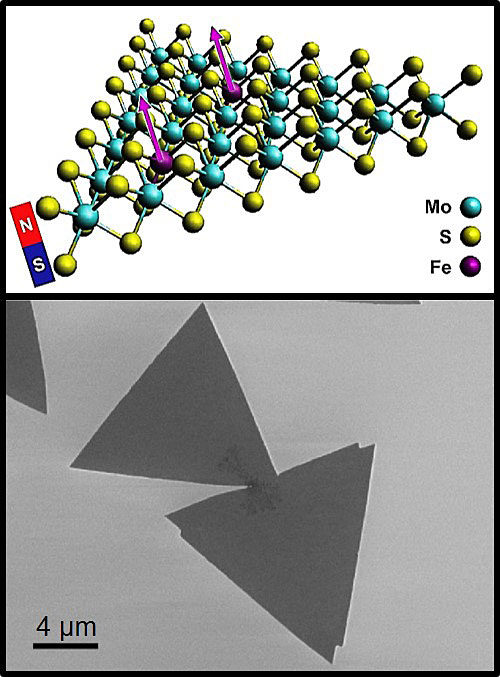Making 2-D Magnetic Semiconductors Through Substitutions
July 27, 2020
 enlarge
enlarge
(Top) A schematic cross section of an Fe-doped MoS2 monolayer. Magnetism is introduced by the aligned spin of doped Fe atoms. (Bottom) A scanning electron microscope image of the as-grown Fe-doped MoS2 monolayer.
What is the scientific achievement?
A collaborative team of researchers, led by CFN users from Stevens Institute of Technology, demonstrated room-temperature ferromagnetism in the two-dimensional (2-D) semiconductor molybdenum disulfide (MoS2). Small substitutions of iron (Fe) for molybdenum during the material growth process are sufficient to create ferromagnetism, without detrimentally affecting other properties of the material.
Why does this achievement matter?
Previous efforts to form 2-D dilute magnetic semiconductors through extrinsic doping or bulk crystal growth have produced substandard materials. This work provides new dilute magnetic semiconductor 2-D materials, with opportunities to combine them in multilayer stacks for quantum information science or spintronics.
What are the details?
Two-dimensional semiconductors, including transition metal dichalcogenides, are of interest in electronics and photonics but remain nonmagnetic in their intrinsic form. Previous efforts to form 2-D dilute magnetic semiconductors have utilized extrinsic doping techniques or bulk crystal growth, detrimentally affecting uniformity, scalability, or the Curie temperature. The work demonstrates an in situ substitutional doping of Fe atoms into MoS2 monolayers via chemical vapor deposition. The iron atoms substitute Mo sites in MoS2 crystals, as confirmed by transmission electron microscopy and Raman signatures. We uncovered an Fe-related spectral transition of Fe:MoS2 monolayers at 2.28 eV above the pristine bandgap that displays pronounced ferromagnetic hysteresis. The microscopic origin of this hysteresis is further corroborated by density functional theory calculations of dipole-allowed transitions in Fe:MoS2. Using spatially integrating magnetization measurements and spatially resolving nitrogen-vacancy center magnetometry, the team showed that Fe:MoS2 monolayers remain magnetized even at ambient conditions, manifesting ferromagnetism at room temperature.
CFN Capabilities
The CFN Electron Microscopy Facility was used to perform high-angle annular dark-field transmission electron microscopy measurements.
Publication Reference
S. Fu†,1, K. N. Kang†,1, K. Shayan†,2,3,4, A. Yoshimura5, S. Dadras4, X. Wang1, L. H. Zhang6, S. Chen1, N. Liu2,3, A. Jindal7, X. Li2,3, A. N. Pasupathy7, A. N. Vamivakas4, V. Meunier5, S. Strauf*,2,3, and E. H. Yang*,1,3, Enabling Room Temperature Ferromagnetism in Monolayer MoS2 via in situ Iron-doping, Nature Communications 11, 2034 (2020).
Collaborating Institutions:
1 Department of Mechanical Engineering, Stevens Institute of Technology, Hoboken, New Jersey
2 Department of Physics, Stevens Institute of Technology, Hoboken, New Jersey
3 Center for Quantum Science and Engineering, Stevens Institute of Technology, Hoboken, New Jersey
4 Institute of Optics, University of Rochester, Rochester, New York
5 Department of Physics, Applied Physics, and Astronomy, Rensselaer Polytechnic Institute, Troy, New York
6 Center of Functional Nanomaterials, Brookhaven National Laboratory, Upton, New York
7 Department of Physics, Columbia University, New York, New York
†These authors contributed equally to this work.
DOI: https://doi.org/10.1038/s41467-020-15877-7
BNL Newsroom: https://www.bnl.gov/newsroom/news.php?a=217237
Stevens News Release: https://www.stevens.edu/news/atomically-thin-magnets-next-generation-spin-and-quantum-electronics
Acknowledgement of Support
S. S. acknowledges financial support by the National Science Foundation (NSF) under Grant NSF-DMR-1809235, NSF-EFRI-1641094, and ECCS-MRI-1531237. E. H. Y. acknowledges financial support by the Air Force Office of Scientific Research under Grant FA9550-11-10272 and the NSF under Grant ECCS-MRI-1531237. A. Y. acknowledges the support of the NSF under Grant NSF-ECCS-1608171. Magnetization measurements are supported by the NSF-MRSEC program through Columbia in the Center for Precision Assembly of Superstratic and Superatomic Solids (DMR-1420634). A. N. V. acknowledges the support by the NSF under Grant NSF-CAREER-DMR-1553788 and the Air Force Office of Scientific Research under Grant FA9550-19-1-0074. DFT calculations were performed in the Center for Computational Innovations at Rensselaer Polytechnic Institute. This research was carried out in part at the Center for Functional Nanomaterials, Brookhaven National Laboratory, which is supported by the US Department of Energy, Office of Basic Energy Sciences, under Contract No. DE-SC0012704. This research used microscopy resources, which was partially funded by the NSF via Grant NSF-DMR-0922522, within the Laboratory for Multiscale Imaging (LMSI) at Stevens Institute of Technology. This work was also partially carried out at the Micro Device Laboratory (MDL) at Stevens Institute of Technology, funded with support from W15QKN-05-D-0011
2020-17427 | INT/EXT | Newsroom









